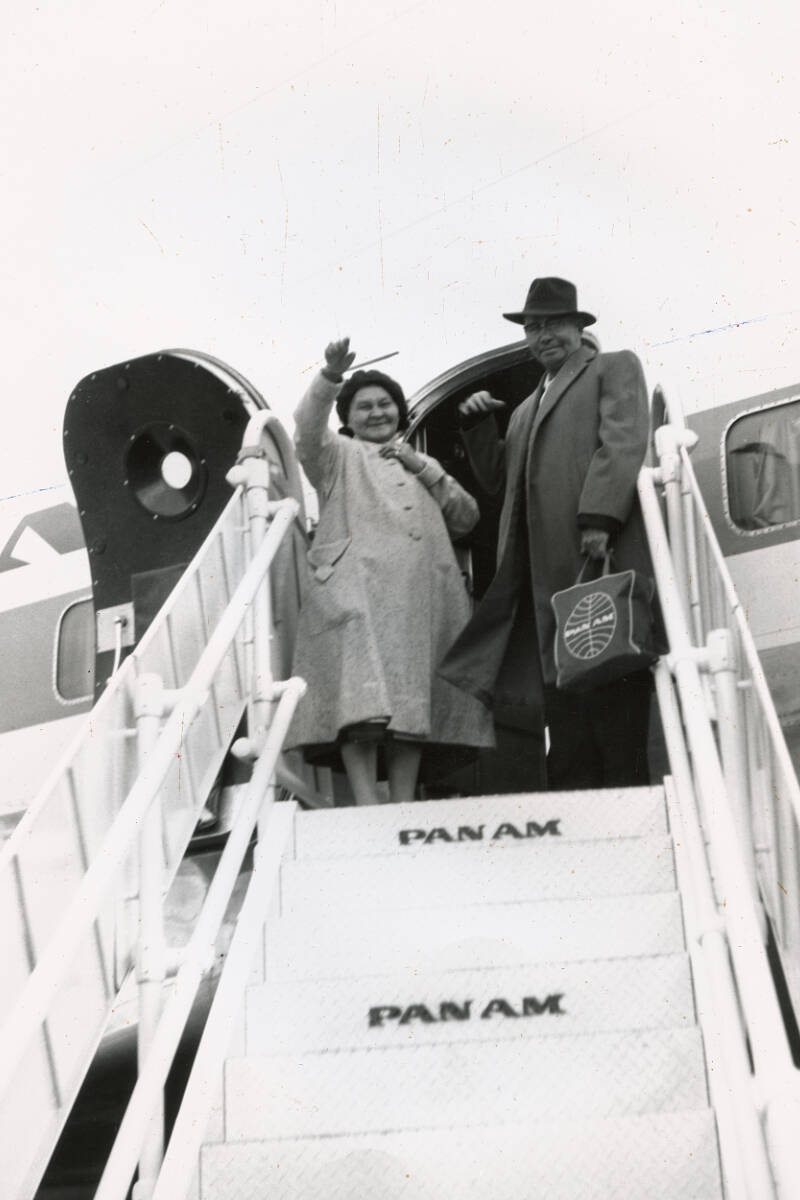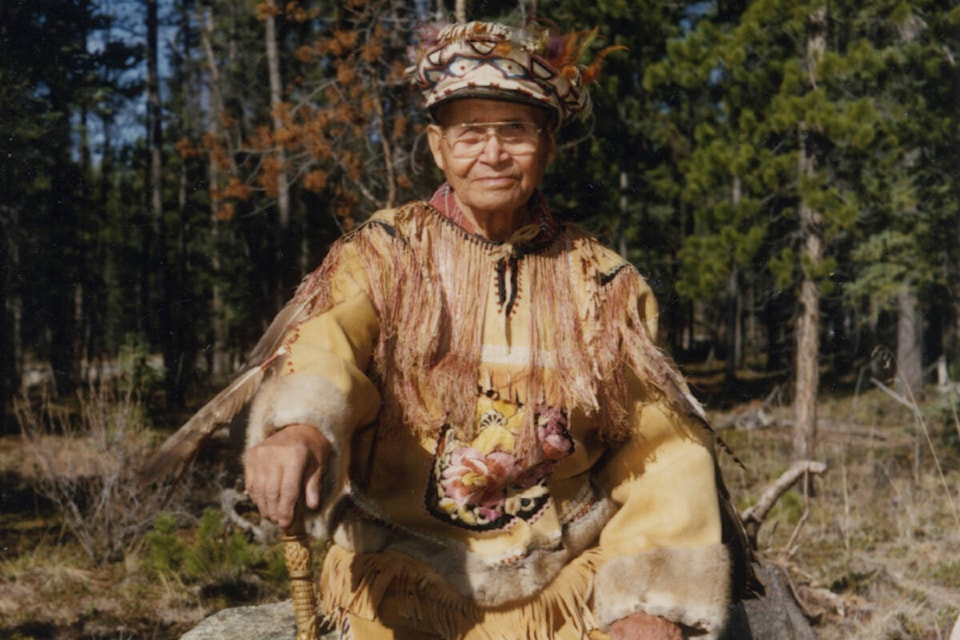On the evening of June 6, a crowd attended the ceremony for 2023 inductees to the Yukon Transportation Hall of Fame. Held at the Yukon Transportation Museum in Whitehorse, the gathering saw four individuals honoured for their contributions to the territory’s transportation industry.
Among the attendees was Jessie Dawson, an elder of the Kwanlin Dün First Nation and the granddaughter of George Dawson. She and her 91-year-old father and other family members were there to celebrate her grandfather’s induction into the hall.
“I was involved in the nomination process, because […] I could never speak highly enough of [my grandfather] and all the work that he’s done for people. It didn’t matter who you were, if you were his friend, you were a friend,” says Jessie.
“That’s the kind of man he was.”
George, who passed away in 1989, built himself a towering legacy during his lifetime, in relation to the Yukon’s transportation industry and as a family man and hereditary chief of the Ta’an Kwach’an Council.
Born in 1902 at Lake Laberge, George spent his formative years in wood camps due to his father’s work cutting wood for steamboats. This experience began a lifelong passion for the Yukon’s large riverboats.
As a youth, George worked for his uncle Jim Boss, a storied figure in Yukon history, transporting freight and mail by horse-drawn sleigh to folks living at Lake Laberge and down the Yukon River.
At roughly 16 years of age, he began working on the steamer Selkirk on its route to Dawson City. After that, George worked on several other riverboats, including the British Yukon Navigation Company steamer Aksala in the early 1920s, and earned himself a reputation as a competent navigator.
“He talked about being behind the wheel of the Aksala going down river from Dawson to Eagle, Alaska because he knew the river well, better than many of the captains,” says Linda Johnson, a Yukon archivist and historian who was a close friend of George during his lifetime.
“He lived on the river all his early life, so he was extremely knowledgeable about currents and sandbars and the shifting pathways of the river. The Yukon River changes every year, so you really have to be able to read the river to be safe.”
In 1923, George met his future wife, Rachel. Several years later, a then-married George and his family would relocate to Whitehorse. In Whitehorse, he took a job working the docks, where he quickly became “well-known and respected,” according to biographical information provided by the Yukon government.

In the wake of Japan’s attack on Pearl Harbour in December of 1941, when American troops and equipment arrived in the Yukon to build the Alaska Highway, George stepped up to help. He recruited and oversaw an all-First Nations crew and helped surveyors from the U.S. Army to scout potential routes for the pioneer road.
When asked about George and his First Nations crew’s impact on the construction of the Alaska Highway in the Yukon, Johnson tells the News, “They were vital. They were knowledgeable about all the trails — they knew the land, they knew the routes. The First Nations crew was essential.”
In his older years, George was passionate about Yukon history and the boats and waterways that had captivated him in his youth. During the summer months in Whitehorse, he offered personal tours of the SS Klondike to family, friends and others.
And while the 2023 ceremony for inductees to the Yukon Transportation Hall of Fame honoured George for his contributions to transportation infrastructure and history in the Yukon, Jessie remembers him as so much more than a titan of transport.
She recalls that when she was a small child, her grandfather was dismayed at the state of many First Nations graveyards in the territory. He sought a small government grant to address the issue and travelled with his family to repair grave fences and spirit houses.
“My grandfather and his closest relatives and friends were very concerned about the state our First Nations’ graveyards were in. So he applied to the government for a grant, and I guess they didn’t have much money. But he got enough supplies, like lumber, paint and nails. And after that, as kids, we went with him from community to community […], and Grandpa’s job was to fix up the old spirit houses and fences,” Jessie tells the News.
“And our jobs were to learn how to respect our loved ones that have passed on and how to take care of their graves.”
In addition to looking after the burial sites of his ancestors and imparting respect in his family for those who came before them, George was a deeply committed father who went above and beyond for his kids.
Jessie recalls that her grandfather gave up his status as a First Nations person to get his children — her aunt and uncle — out of residential school in Carcross where they were being mistreated.
“My grandma did not like how they were being treated there […] they weren’t treated very good. So my grandma told my grandpa, ‘I don’t care what you have to do, but I want my kids out of there. I don’t want my kids in that place.’ And that’s when he enfranchised and gave up his rights as a First Nations [person].”
George succeeded in getting his kids out of the residential school, and he ultimately regained his status.
“When Bill C-31 was dealt with here in Canada, my grandfather got his status back. He gave up his rights to get his kids out of residential school, but that didn’t stop some of his grandkids from going to those places,” says Jessie, who adds that she herself is a residential school survivor.
George’s love of children extended beyond his brood, with Jessie recounting the tale of a boy in the Kwanlin Dün community visiting her grandfather’s home to drop something off on behalf of his mother. When the boy did not swiftly return, his mother went to George’s home and found the duo making music and dancing.
“She walked up to the door, knocked, and no answer. But she could hear drumming and singing in the house. So she opened the door […] and she was so surprised. My grandfather was sitting in his favourite chair with his drum, singing and drumming, and her son, who was pretty young, was dancing up a storm.”
Throughout his lifetime, George received numerous accolades, including a medal and certificate of achievement from Queen Elizabeth II in 1976.
Speaking to George’s most recent honour, Johnson says, “I am very pleased to see Mr. George Dawson honoured in the Yukon Transportation Hall of Fame because of his many, many contributions to Yukon transportation and heritage, and his generous support of all Yukon people throughout his lifetime.”
Contact Matthew Bossons at matthew.bossons@yukon-news.com
